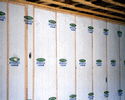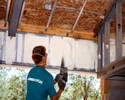B7. Install Wall Insulation
Description

The purpose of wall insulation is to reduce the amount of heat that flows from a dwelling unit through the walls to the cold outside air. By reducing this heat loss, wall insulation reduces the amount of energy needed to heat the dwelling unit. Wall insulation also can save on cooling costs and reduce overheating in the summer.
A material’s resistance to heat flow is measured in units of “R-value.” The higher the R-value, the better the insulating properties. The R-value of insulation depends on the type of insulation and its thickness.
Applicability
- Single-family and multifamily buildings with uninsulated walls
- Buildings located in heating degree day zones 1.5 and above
Types
- Sprayed or blown insulation
- cellulose
- foams
- blown fibers
- Rigid board
- foam
- fiberglass
Considerations
- A professional insulation contractor must implement this Energy Conservation Measure (ECM).

- Cavity fill insulation must be compatible with building materials.
- Cavity fill insulation should be blown in under pressure or expanded within the wall to insure even distribution.
- All materials must meet local codes.
- Exterior and interior insulating panels should be protected from impacts, vandalism, and abrasions.
- Exterior insulation panels should be protected from weather and ultraviolet radiation.
- Finish and detailing around doors, windows, and other openings should be considered so as not to detract from building appearance and operation of equipment.
Performance/Economics
- Increasing wall insulation can reduce energy costs approximately 15 to 25 percent.
Resources/Links
Energy Conservation for Housing – A Workbook, HUD, September 1998. Pages 7-29 through 7-32 address roof insulation, applications, and effectiveness.
Wall Insulation. Part of the U.S. Department of Energy's Consumer's Guide.
DOE Insulation Guidance. Information on insulation levels for existing and new homes from the U.S. Department of Energy.
Improving Energy Efficiency in Apartment Buildings, American Council for an Energy-Efficient Economy, 1995. ISBN 0-918249-23-6. Pages 96 and 97 address insulation in apartment buildings.
Consumer Guide to Home Energy Savings, American Council for an Energy Efficient Economy, 1999, ISBN 0-918249-38-4. Pages 21 through 27 address insulation methods and strategies.
The Home Energy Saver. Tool to calculate home energy use and savings opportunities.
Simply Insulate. A website of the North American Insulation Manufacturers Association that provides a variety of information about the benefits of insulating homes. Features include installation information and tools that determine the necessary insulation in your state and your projected energy savings.
|
TURN OFF UTILITIES: Turn off electricity, gas, propane, and other utilities before starting repairs, cleaning, or installations to avoid accident or injury. BE AWARE OF LEAD-BASED PAINT HAZARDS: Many residences built before 1978 have paint that contains lead, which can pose a serious health hazard if paint, chips, and dust are not handled properly. See the U.S. Environmental Protection Agency (EPA) lead brief before disturbing painted surfaces in homes of this vintage. Follow the HUD "Lead-Safe Housing Rule" for requirements for notification, evaluation and reduction of lead-based paint hazards. BE AWARE OF ASBESTOS HAZARDS: Homes older than 1977 may have building products that contain asbestos such as insulation, high-temperature gaskets, roofing and siding shingles, and vinyl sheet flooring. See the EPA asbestos brief before disturbing such materials. BE AWARE OF MOLD AND MOISTURE HAZARDS: Molds can gradually destroy materials they grow on; can irritate the eyes, skin, nose, throat, and lungs of both mold-allergic and non-allergic people; can cause asthma attacks in people with asthma who are allergic to mold; and can cause other serious health problems. To learn more about preventing and cleaning up mold in homes, see these mold guides and the EPA brief on What to Wear When Cleaning Moldy Areas. |